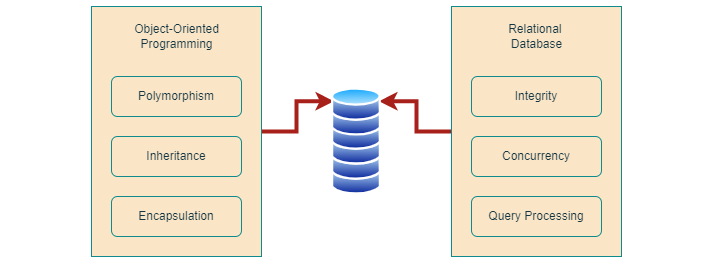
 Data Structure
Data Structure Networking
Networking RDBMS
RDBMS Operating System
Operating System Java
Java MS Excel
MS Excel iOS
iOS HTML
HTML CSS
CSS Android
Android Python
Python C Programming
C Programming C++
C++ C#
C# MongoDB
MongoDB MySQL
MySQL Javascript
Javascript PHP
PHP
- Selected Reading
- UPSC IAS Exams Notes
- Developer's Best Practices
- Questions and Answers
- Effective Resume Writing
- HR Interview Questions
- Computer Glossary
- Who is Who
Object Database Conceptual Design
You should consider the needs of the applications during designing a database. Object databases offer a unique approach to database design that can be beneficial in certain situations. In this article, we will discuss the conceptual design of object databases.
Object database design
Object-Oriented Model is process of representing real-world entities as objects in computer programs. It is fundamental aspect of Object Database Conceptual Design. Object-oriented modeling is more flexible and dynamic than traditional relational model. It enables developers to model complex relationships between objects more efficiently. Object-oriented modeling allows for inheritance, encapsulation, and polymorphism. It is easier to maintain and modify code.

Object Database
An object database stores data in the form of objects. These objects can contain both data and methods for accessing and manipulating that data. Object databases work with object-oriented programming languages, like Java and Python.
Differences between Conceptual Design of ODB and RDB:
ODB Design |
RDB Design |
|---|---|
Relationships are handled by relationship properties or reference attributes that include OID(s) of the related objects. |
Relationships among tuples (records) are specified by attributes with matching values. |
Relationships can be represented using single references or collections of references. |
Relationships are limited to being single-valued in each record because multivalued attributes are not permitted in the basic relational model. |
Mapping binary relationships that contain attributes is not straightforward, and it may be preferable to create a separate class to represent the relationship. |
M:N relationships must be represented not directly but as a separate relation (table). |
Inheritance is handled using the inheritance constructs such as derived (:) and extends. |
No built-in construct exists for inheritance in the basic relational model. Several options are available to choose from. |
Operations are part of the class specifications and need to be specified early on in the design. |
Operations may be delayed until the implementation phase. |
The object model mandates the predefinition of a set of valid behaviors or operations. |
The relational model does not mandate the database designers to predefine a set of valid behaviors or operations. |
Supports ad hoc queries and transactions. |
Encapsulation is a fundamental principle, and ad hoc queries and transactions are not encouraged. |
Mapping an EER Schema to an ODB Schema
Mapping an EER schema to an ODB schema is a process of designing the type declarations of object classes for an Object Database Management System (ODBMS) from an Entity-Relationship (ER) diagram. Here are the step-wise instructions to perform this mapping:
Step-1
Create an ODL class for each EER entity type or subclass. The ODL class should include all the attributes of the EER class. Multivalued attributes are typically declared by using set, bag, or list constructors. Declare an extent for each class and specify any key attributes as keys of the extent.
Step-2
Add relationship properties or reference attributes for each binary relationship into the ODL classes that participate in the relationship. Depending on the cardinality ratio of the binary relationship, the relationship properties or reference attributes may be single-valued or collection types.
Step-3
Include appropriate operations for each class. These are not available from the EER schema and must be added to the database design by referring to the original requirements.
Step-4
An ODL class that corresponds to a subclass in the EER schema inherits the type and methods of its superclass in the ODL schema. Its specific (non-inherited) attributes, relationship references, and operations are specified.
Step-5
Weak entity types can be mapped in the same way as regular entity types. An alternative mapping is possible for weak entity types that do not participate in any relationships except their identifying relationship.
Step-6
Categories (union types) in an EER schema are difficult to map to ODL. One way is to create a class to represent the category and define 1:1 relationships between the category and each of its superclasses.
Step-7
An n-ary relationship with degree n > 2 can be mapped into a separate class, with appropriate references to each participating class. An M:N binary relationship may also use this mapping option if desired.
After completing the structural mapping, add operations for each class, including constructor and destructor methods that check for constraints. The mapping can be applied to a subset of the database schema in the context of the ODMG object database standard.
Challenges in Object Database Design
Object Database Conceptual Design has many benefits and challenges. It can be complex. It may require significant amount of time and effort to create a robust and efficient object model. Integration with existing systems can also be challenging. As object databases may need to work with other databases that use the relational model. Performance issues can arise due to the complex relationships between objects.
Conclusion
When designing database, it is important to consider the needs of the applications. It is unique way to database design that is more flexible and dynamic than traditional relational models. The conceptual design of object databases involves object-oriented modeling. Which allows for inheritance, encapsulation, and polymorphism. Mapping an EER schema to ODB schema involves several steps, including creating ODL classes, adding relationship properties, and including appropriate operations for each class. However, there are also challenges in object database design. These are complexity, integration with existing systems, and performance issues due to the complex relationships between objects.

